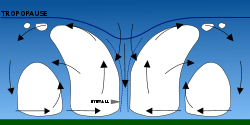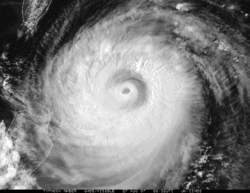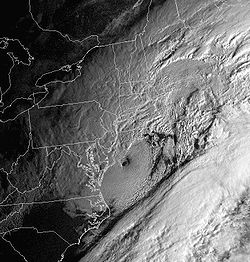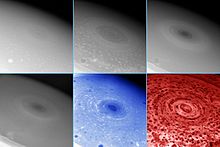
Eye (cyclone)
About this schools Wikipedia selection
SOS Children volunteers helped choose articles and made other curriculum material Sponsoring children helps children in the developing world to learn too.
The eye is a region of mostly calm weather at the centre of strong tropical cyclones. The eye of a storm is a roughly circular area, typically 30–65 km (20–40 miles) in diameter. It is surrounded by the eyewall, a ring of towering thunderstorms where the most severe weather occurs. The cyclone's lowest barometric pressure occurs in the eye, and can be as much as 15% lower than the atmospheric pressure outside the storm.
In strong tropical cyclones, the eye is characterized by light winds and clear skies, surrounded on all sides by a towering, symmetric eyewall. In weaker tropical cyclones, the eye is less well-defined, and can be covered by the central dense overcast, which is an area of high, thick clouds that show up brightly on satellite imagery. Weaker or disorganized storms may also feature an eyewall that does not completely encircle the eye, or have an eye that features heavy rain. In all storms, however, the eye is the location of the storm's minimum barometric pressure: the area where the atmospheric pressure at sea level is the lowest.
Structure
A typical tropical cyclone will have an eye of approximately 30–65 km (20–40 mi) across, usually situated at the geometric centre of the storm. The eye may be clear or have spotty low clouds (a clear eye), it may be filled with low- and mid-level clouds (a filled eye), or it may be obscured by the central dense overcast. There is, however, very little wind and rain, especially near the centre. This is in stark contrast to conditions in the eyewall, which contains the storm's strongest winds. Due to the mechanics of a tropical cyclone, the eye and the air directly above it are warmer than their surroundings.
While normally quite symmetric, eyes can be oblong and irregular, especially in weakening storms. A large ragged eye is a non-circular eye which appears fragmented, and is an indicator of a weak or weakening tropical cyclone. An open eye is an eye which can be circular, but the eyewall does not completely encircle the eye, also indicating a weakening, moisture-deprived cyclone. Both of these observations are used to estimate the intensity of tropical cyclones via Dvorak analysis. Eyewalls are typically circular; however, distinctly polygonal shapes ranging from triangles to hexagons occasionally occur.
While typical mature storms have eyes that are a few dozen miles across, rapidly intensifying storms can develop an extremely small, clear, and circular eye, sometimes referred to as a pinhole eye. Storms with pinhole eyes are prone to large fluctuations in intensity, and provide difficulties and frustrations for forecasters.
Small eyes—those less than 10 nmi (19 km, 12 mi) across—often trigger eyewall replacement cycles, where a new eyewall begins to form outside the original eyewall. This can take place anywhere from ten to a few hundred miles (fifteen to hundreds of kilometers) outside the inner eye. The storm then develops two concentric eyewalls, or an "eye within an eye". In most cases, the outer eyewall begins to contract soon after its formation, which chokes off the inner eye and leaves a much larger but more stable eye. While the replacement cycle tends to weaken storms as it occurs, the new eyewall can contract fairly quickly after the old eyewall dissipates, allowing the storm to re-strengthen. This may trigger another cycle of eyewall replacement.
Eyes can range in size from 320 km (200 mi) ( Typhoon Carmen) to a mere 3 km (1.9 mi) ( Hurricane Wilma) across. While it is uncommon for storms with large eyes to become very intense, it does occur, especially in annular hurricanes. Hurricane Isabel was the eleventh most powerful North Atlantic hurricane in recorded history, and sustained a large, 65–80 km (40–50 mi)-wide eye for a period of several days.
Formation and detection
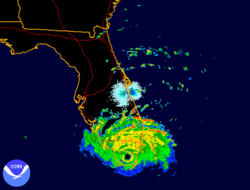
Tropical cyclones typically form from large, disorganized areas of disturbed weather in tropical regions. As more thunderstorms form and gather, the storm develops rainbands which start rotating around a common centre. As the storm gains strength, a ring of stronger convection forms at a certain distance from the rotational centre of the developing storm. Since stronger thunderstorms and heavier rain mark areas of stronger updrafts, the barometric pressure at the surface begins to drop, and air begins to build up in the upper levels of the cyclone. This results in the formation of an upper level anticyclone, or an area of high atmospheric pressure above the central dense overcast. Consequently, most of this built up air flows outward anticyclonically above the tropical cyclone. Outside the forming eye, the anticyclone at the upper levels of the atmosphere enhances the flow towards the centre of the cyclone, pushing air towards the eyewall and causing a positive feedback loop.
However, a small portion of the built-up air, instead of flowing outward, flows inward towards the center of the storm. This causes air pressure to build even further, to the point where the weight of the air counteracts the strength of the updrafts in the center of the storm. Air begins to descend in the centre of the storm, creating a mostly rain-free area; a newly formed eye.
There are many aspects of this process which remain a mystery. Scientists do not know why a ring of convection forms around the centre of circulation instead of on top of it, or why the upper-level anticyclone only ejects a portion of the excess air above the storm. Many theories exist as to the exact process by which the eye forms: all that is known for sure is that the eye is necessary for tropical cyclones to achieve high wind speeds.
The formation of an eye is almost always an indicator of increasing tropical cyclone organisation and strength. Because of this, forecasters watch developing storms closely for signs of eye formation.
For storms with a clear eye, detection of the eye is as simple as looking at pictures from a weather satellite. However, for storms with a filled eye, or an eye completely covered by the central dense overcast, other detection methods must be used. Observations from ships and Hurricane Hunters can pinpoint an eye visually, by looking for a drop in wind speed or lack of rainfall in the storm's centre. In the United States, South Korea, and a few other countries, a network of NEXRAD Doppler weather radar stations can detect eyes near the coast. Weather satellites also carry equipment for measuring atmospheric water vapor and cloud temperatures, which can be used to spot a forming eye. In addition, scientists have recently discovered that the amount of ozone in the eye is much higher than the amount in the eyewall, due to air sinking from the ozone-rich stratosphere. Instruments sensitive to ozone perform measurements, which are used to observe rising and sinking columns of air, and provide indication of the formation of an eye, even before satellite imagery can determine its formation.
Associated phenomena
Eyewall replacement cycles
Eyewall replacement cycles, also called concentric eyewall cycles, naturally occur in intense tropical cyclones, generally with winds greater than 185 km/h (115 mph), or major hurricanes ( Category 3 or above). When tropical cyclones reach this intensity, and the eyewall contracts or is already sufficiently small (see above), some of the outer rainbands may strengthen and organize into a ring of thunderstorms—an outer eyewall—that slowly moves inward and robs the inner eyewall of its needed moisture and angular momentum. Since the strongest winds are located in a cyclone's eyewall, the tropical cyclone usually weakens during this phase, as the inner wall is "choked" by the outer wall. Eventually the outer eyewall replaces the inner one completely, and the storm can re-intensify.
The discovery of this process was partially responsible for the end of the U.S. government's hurricane modification experiment Project Stormfury. This project set out to seed clouds outside the eyewall, causing a new eyewall to form and weakening the storm. When it was discovered that this was a natural process due to hurricane dynamics, the project was quickly abandoned.
Almost every intense hurricane undergoes at least one of these cycles during its existence. Hurricane Allen in 1980 went through repeated eyewall replacement cycles, fluctuating between Category 5 and Category 3 status on the Saffir-Simpson Scale several times. Hurricane Juliette was a rare documented case of triple eyewalls.
Moats
A moat in a tropical cyclone is a clear ring outside the eyewall, or between concentric eyewalls, characterized by slowly sinking air, little or no precipitation, and strain-dominated flow. The moat between eyewalls is just one example of a rapid filamentation zone, or an area in the storm where the rotational speed of the air changes greatly in proportion to the distance from the storm's centre. Such strain-dominated regions can potentially be found near any vortex of sufficient strength, but are most pronounced in strong tropical cyclones.
Eyewall mesovortices
Eyewall mesovortices are small scale rotational features found in the eyewalls of intense tropical cyclones. They are similar, in principle, to small "suction vortices" often observed in multiple-vortex tornadoes. In these vortices, wind speed can be up to 10% higher than in the rest of the eyewall. Eyewall mesovortices are most common during periods of intensification in tropical cyclones.
Eyewall mesovortices often exhibit unusual behavior in tropical cyclones. They usually rotate around the low pressure centre, but sometimes they remain stationary. Eyewall mesovortices have even been documented to cross the eye of a storm. These phenomena have been documented observationally, experimentally, and theoretically.
Eyewall mesovortices are a significant factor in the formation of tornadoes after tropical cyclone landfall. Mesovortices can spawn rotation in individual thunderstorms (a mesocyclone), which leads to tornadic activity. At landfall, friction is generated between the circulation of the tropical cyclone and land. This can allow the mesovortices to descend to the surface, causing large outbreaks of tornadoes.
Stadium effect
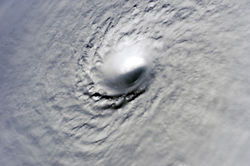
The stadium effect is a phenomenon observed in strong tropical cyclones. It is a fairly common event, where the clouds of the eyewall curve outward from the surface with height. This gives the eye an appearance resembling an open dome from the air, akin to a sports stadium. An eye is always larger at the top of the storm, and smallest at the bottom of the storm because the rising air in the eyewall follows isolines of equal angular momentum, which also slope outward with height. This phenomenon refers to the characteristics of tropical cyclones with very small eyes, where the sloping phenomenon is much more pronounced.
Eye-like features
An eye-like structure is often found in intensifying tropical cyclones. Similar to the eye seen in hurricanes or typhoons, it is a circular area at the circulation centre of the storm in which convection is absent. These eye-like features are most normally found in intensifying tropical storms and hurricanes of Category 1 strength on the Saffir-Simpson Scale. For example, an eye-like feature was found in Hurricane Beta when the storm had maximum wind speeds of 50 mph. These eye-like features are typically not visible on visible wavelengths or infrared wavelengths from space, however, they are easily seen on microwave satellite imagery. The development of this feature at middle levels of the atmosphere is similar to the formation of the complete eye, but its position might be horizontally displaced due to vertical wind shear.
Hazards
Though the eye is by far the calmest part of the storm, with no wind at the center and typically clear skies, over the ocean it is possibly the most hazardous area. In the eyewall, wind-driven waves are all traveling in the same direction. In the centre of the eye, however, waves from all directions converge, creating erratic crests which can build on each other, creating rogue waves. The maximum height of hurricane waves is unknown, but measurements of Hurricane Ivan, when it was a category four hurricane, estimated that waves near the eyewall were in excess of 40 meters (130 ft) from peak to trough.
A common mistake, especially in areas where hurricanes are uncommon, is for residents to wander outside to inspect the damage while the eye passes over, thinking the storm is over. They are then caught completely by surprise by the violent winds in the opposite eyewall. The National Weather Service strongly discourages leaving shelter while the eye passes over.
Other storms
Though only tropical cyclones have structures which are officially called "eyes", there are other storms which can exhibit eye-like structures:
Polar lows
Polar lows are mesoscale weather systems (typically smaller than 1,000 km or 600 miles (970 km) across) found near the poles. Like tropical cyclones, they form over relatively warm water, can feature deep convection (thunderstorms), and feature winds of gale force (51 km/h, 32 mph) or greater. Unlike storms of tropical nature, however, they thrive in much colder temperatures and at much higher latitudes. They are also smaller and last for shorter durations (few last longer than a day or so). Despite these differences, they can be very similar in structure to tropical cyclones, featuring a clear eye surrounded by an eyewall and rain/snow bands.
Extratropical storms
Extratropical storms are areas of low pressure which exist at the boundary of different air masses. Almost all storms found at mid-latitudes are extratropical in nature, including classic North American nor'easters and European windstorms. The most severe of these can have a clear "eye" at the site of lowest barometric pressure, though it is usually surrounded by lower, non-convective clouds and is found near the back end of the storm.
Subtropical storms
Subtropical storms are cyclones which have some extratropical characteristics and some tropical characteristics. As such, they may have an eye, but are not true tropical storms. Subtropical storms can be very hazardous, with high winds and seas, and often evolve into true tropical storms. As such, the National Hurricane Centre began including subtropical storms in its naming scheme in 2002.
Tornadoes
Tornadoes are destructive, small-scale storms, which produce the fastest winds on earth. There are two main types—single-vortex tornadoes, which consist of a single spinning column of air, and multiple-vortex tornadoes, which consist of small suction vortices, resembling mini-tornadoes themselves, all rotating around a common centre. Both of these types of tornadoes are theorized to have calm centers, referred to by some meteorologists as "eyes". These theories are supported by doppler velocity observations by weather radar and eyewitness accounts.
Extraterrestrial storms
NASA reported in November 2006 that the Cassini spacecraft observed a 'hurricane-like' storm locked to the south pole of Saturn that had a clearly defined eyewall. This observation is particularly notable because eyewall clouds had not previously been seen on any planet other than Earth (including a failure to observe an eyewall in the Great Red Spot of Jupiter by the Galileo spacecraft). In 2007, very large vortices on both poles of Venus were observed by the Venus Express mission of the European Space Agency to have a dipole eye structure.

